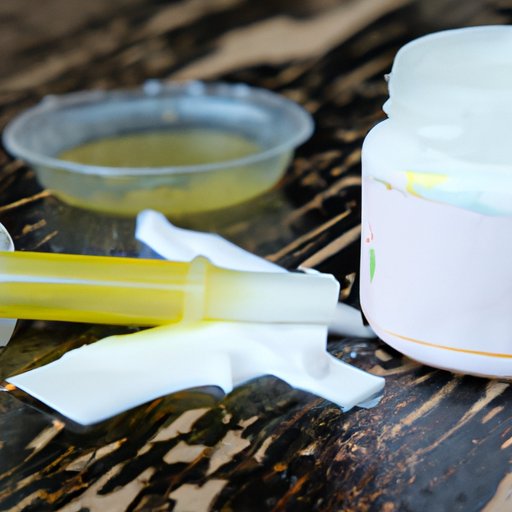
Introduction
Glue is a versatile adhesive that can be used for a variety of projects, from school assignments to DIY home repairs. The purpose of this article is to provide a step-by-step guide on how to make glue at home. Whether you’re a craft enthusiast or an eco-conscious individual, this article is for you.
Step-by-Step Instructions
Before we dive into the recipes, here are the materials you’ll need:
- Water
- Flour
- Sugar or corn syrup
- Vinegar
Now that we have our materials, let’s get started on making glue.
- Flour glue:
- Paper mache glue:
- Slime glue:
For a simple homemade glue that is great for paper mache, mix together 1/4 cup of flour and 1 cup of water in a saucepan. Heat the mixture over medium heat until it thickens. Remove from heat and whisk in 1 tablespoon of sugar or corn syrup. Allow to cool before use.
To make paper mache glue, mix together 1 part flour and 2 parts water until a paste forms. Add 1 tablespoon of vinegar per cup of paste to prevent mold growth. Stir thoroughly and use for paper mache projects.
If you’re looking to make slime, mix together 1/2 cup of school glue and 1/2 cup of water in a bowl. Add 1/2 teaspoon of baking soda and stir. In a separate container, mix together 1 tablespoon of contact lens solution and 1 tablespoon of baking powder. Add this to the glue mixture and stir until a slime forms.
Types of Glue and How to Make Them
In addition to the above-mentioned glue recipes, here are a few more types of adhesives you can make at home:
- Eggshell glue:
- Milk glue:
- Gelatin glue:
To make eggshell glue, grind eggshells into a fine powder and mix with water until a paste forms. Allow the solution to sit for at least an hour before use.
For an alternative to flour glue, mix 1/2 cup of milk and 2 teaspoons of white vinegar in a bowl. Allow to sit for a few minutes before use.
If you’re working on a woodworking project, mix together 1/4 cup of cold water and 1 tablespoon of gelatin in a bowl. In a separate container, mix together 1/4 cup of boiling water and 1 teaspoon of sugar. Combine the two mixtures and stir until dissolved. Allow to cool before use.
Environmentally Friendly Glue
If you’re looking for a more eco-friendly alternative to traditional store-bought adhesives, here are a few natural ingredients that can be used to make glue:
- Potato starch glue:
- Tree sap glue:
- Casein glue:
Mix together 1/4 cup of potato starch and 1 cup of water in a saucepan. Heat over medium heat, stirring constantly, until the mixture thickens. Remove from heat and allow to cool.
Collect tree sap from a pine tree and heat in a saucepan over low heat until it liquefies. Remove from heat and add a small amount of charcoal or ash to stabilize the sap. Allow to cool before use.
For an eco-friendly alternative to super glue, mix together 1/2 cup of white vinegar and 1 tablespoon of baking soda in a bowl. Slowly add 1/2 cup of powdered milk and stir until a paste forms.
Relevant Tools and Techniques
In order to make glue properly, it’s important to use the right tools and techniques. Here are a few tips:
- Use a kitchen scale to accurately measure ingredients.
- When heating glue, stir constantly to prevent clumping.
- If working with hot glue, use caution to avoid burns.
The Benefits and Limitations of Homemade Glue
There are several benefits to making your glue at home. First and foremost, it’s often cheaper than buying store-bought versions. Secondly, homemade glue is often more sustainable and eco-friendly. However, there are also limitations to homemade glue, such as variations in quality and consistency. To overcome these limitations, it’s important to follow the instructions closely and test the glue before use.
Inspiring Projects Using Homemade Glue
The possibilities are endless when it comes to using homemade glue. Here are a few inspiring project ideas:
- DIY paper mache creations, from masks to piñatas.
- Building birdhouses or other wooden projects using gelatin glue.
- Creating hand-made greeting cards using flour glue.
Conclusion
Making glue at home is a fun and easy way to create your own adhesives for a variety of projects. We hope this article has provided you with the knowledge and tools necessary to make your glue. Remember to choose the recipe that best suits your needs, to follow the instructions closely, and to test the glue before use.





